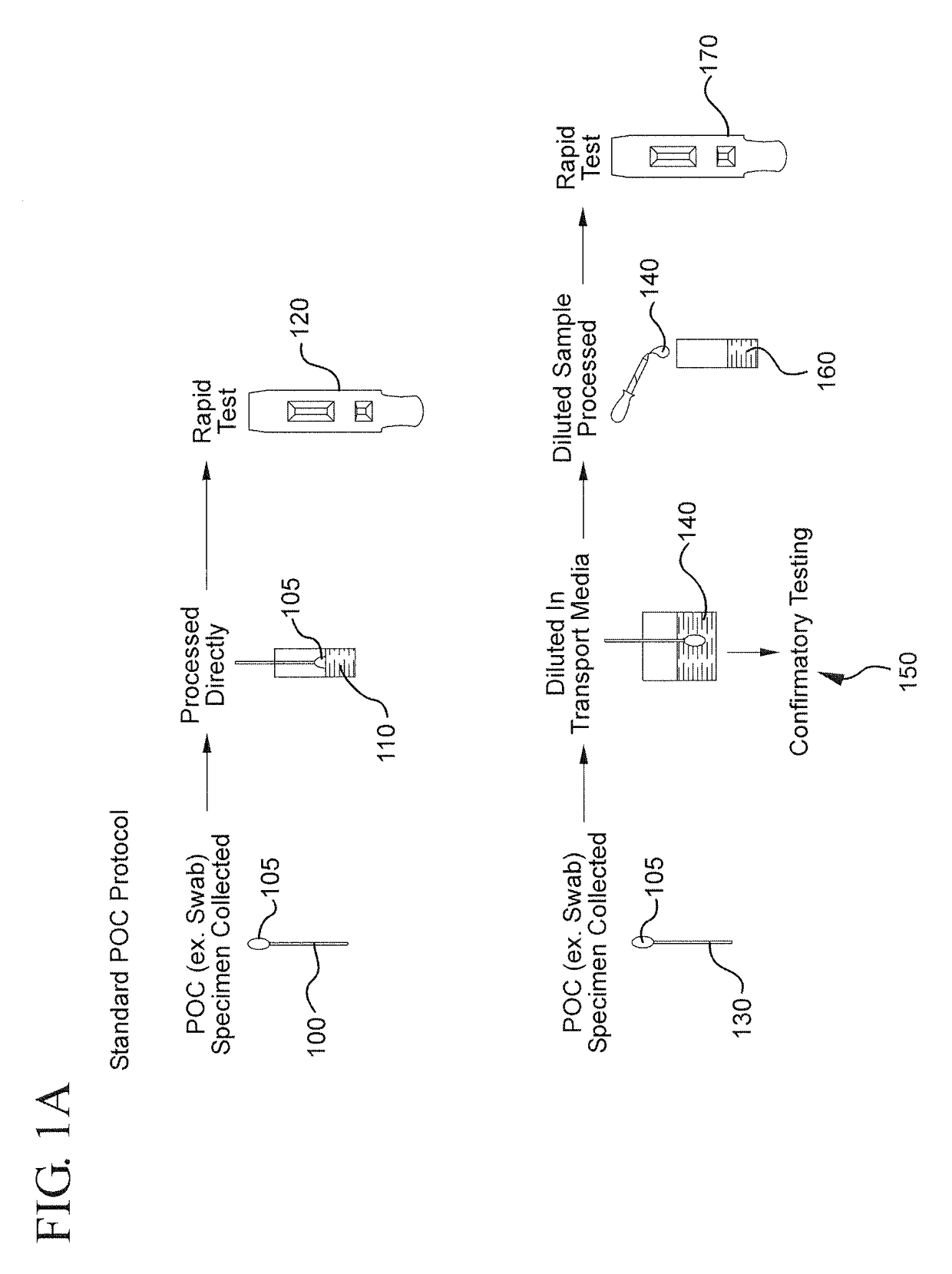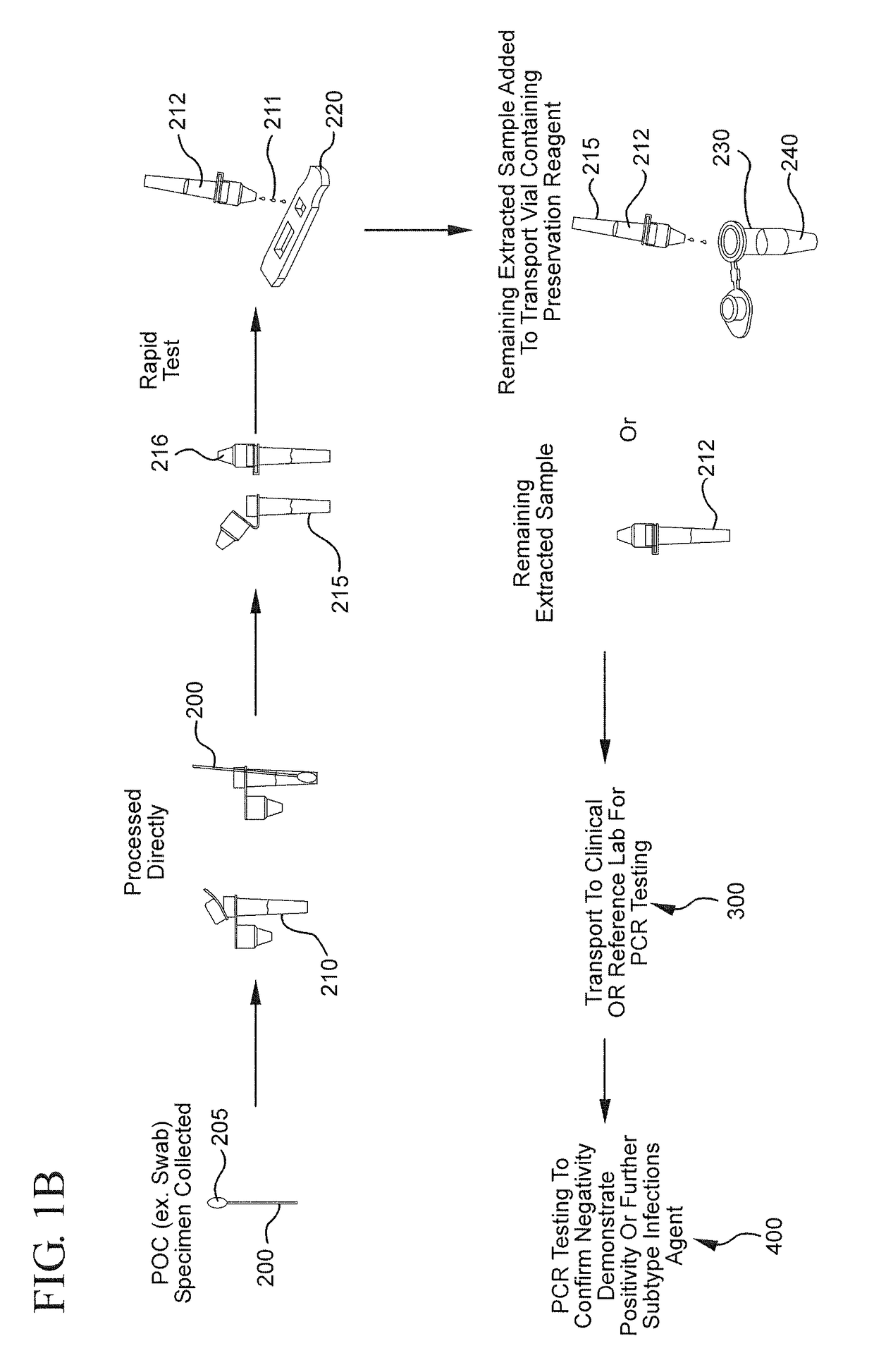Method for linking point of care rapid diagnostic testing results to laboratory-based methods
a rapid diagnostic and laboratory technology, applied in the field of linking point of care rapid diagnostic testing results to laboratory-based methods, can solve problems such as unsuitability for contemplated laboratory tests, and achieve the effect of increasing sample stability
- Summary
- Abstract
- Description
- Claims
- Application Information
AI Technical Summary
Benefits of technology
Problems solved by technology
Method used
Image
Examples
example 1
[0021]The ability to detect influenza viral RNA in samples processed for use in a POC rapid immunoassay was demonstrated using an H1N1 positive clinical specimen collected by upper nasal swab from an individual exhibiting positive flu symptoms. The swab was placed in 3 ml of commercially available transport media (BD™ Universal Viral Transport Media available from Becton Dickinson) and confirmation that the sample tested positive for H1N1 was obtained. For testing, certain 50 μl aliquots of that specimen were obtained. One aliquot was mixed directly with a rapid test processing reagent for the immunoassay and others were further diluted (5×, 25×, 125× or 625×) with stabilization transport diluent prior to mixing with the rapid test processing reagent. Each 50 μl aliquot of sample was combined with 25 μl of rapid test processing reagent. The rapid test processing reagent (tris buffer, NaCl, 6% detergent and pH adjusted to 8.0) was optimized to release and preserve the influenza nucle...
example 2
[0024]Aliquots (50 μl) of each dilution prepared in Example 1 were mixed with 25 μl rapid test processing reagent. One set of processed samples was stored at room temperature (RT) for 5 minutes prior to RNA extraction using a Qiagen Viral RNA miniprep kit according to the manufacturer's instructions. Additional sets of processed samples were stored for 4 hours at either 4° C. or RT prior to RNA extraction. A 5 μl portion of the extracted RNA samples was then used as target for reverse transcription-polymerase chain reaction (RT-PCR) with primers specific for the matrix gene of influenza A virus. The RT-PCR results are shown in FIGS. 2A and 2B. Tables 2 and 3 show the processing conditions corresponding to each lane of the agarose gel of the RT-PCR results shown in FIGS. 2A and 2B.
[0025]
TABLE 2Lanes of Agarose Gel of FIG. 2ALane onProcessing MethodAgarose GelMolecular Weight MarkerMSample diluted 1:5, processed1for rapid test, RNAextraction immediatelySample diluted 1:5, processed2fo...
example 3
[0028]The stability of viral RNA in processed samples was examined using two different rapid test processing reagents optimized for use in the rapid immunoassay for influenza A / B. Sample processing for rapid immunoassays typically involves the use of a relatively gentle lysis treatment mediated by a reagent containing various salts and detergents. Two different formulations for the rapid test processing reagent were examined for compatibility with the described method. Formulation A contained Tris buffer, NaCl, 16% detergent at a pH of 7.8. Formulation B contained Tris buffer, NaCl, 6% detergent at a pH of 8.0. Aliquots of an H1N1 positive clinical specimen described in Example 1 were processed with both formulations, and the processed samples were used immediately for RNA extraction using the Qiagen Viral RNA miniprep kit, or stored at RT and 4° C. for up to 24 hours prior to RNA extraction. A portion of the extracted RNA samples was then used as target for RT-PCR with primers spec...
PUM
| Property | Measurement | Unit |
|---|---|---|
| pH | aaaaa | aaaaa |
| temperature | aaaaa | aaaaa |
| nucleic acid assay | aaaaa | aaaaa |
Abstract
Description
Claims
Application Information
 Login to View More
Login to View More - R&D
- Intellectual Property
- Life Sciences
- Materials
- Tech Scout
- Unparalleled Data Quality
- Higher Quality Content
- 60% Fewer Hallucinations
Browse by: Latest US Patents, China's latest patents, Technical Efficacy Thesaurus, Application Domain, Technology Topic, Popular Technical Reports.
© 2025 PatSnap. All rights reserved.Legal|Privacy policy|Modern Slavery Act Transparency Statement|Sitemap|About US| Contact US: help@patsnap.com



